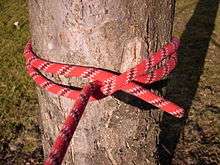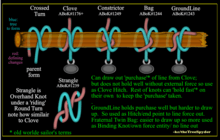Clove hitch
The clove hitch is a type of knot. Along with the bowline and the sheet bend, it is often considered one of the most important knots. A clove hitch is two successive half-hitches around an object. It is most effectively used as a crossing knot. It can be used as a binding knot, but is not particularly secure in that role.[1] A clove hitch made around the rope's own standing part is known as either two half-hitches or buntline hitch, depending on whether the turns of the clove hitch progress away from or towards the hitched object.
Although the name clove hitch is given by Falconer in his Dictionary of 1769, the knot is much older, having been tied in ratlines at least as early as the first quarter of the sixteenth century. This is shown in early sculpture and paintings. A round turn is taken with the ratline and then a hitch is added below. The forward end is always the first to be made fast.
The difference between two half hitches and the clove hitch is that the former, after a single turn around a spar, is made fast around its own standing part, while the latter is tied directly around the spar.
— The Ashley Book of Knots[3]
| Clove hitch | |
|---|---|
 | |
| Category | Hitch |
| Origin | Ancient |
| Related | Slippery hitch, Two half-hitches, Buntline hitch, Cow hitch, Constrictor knot, Ground-line hitch, Lashings, Snuggle hitch |
| Releasing | Jamming |
| Typical use | Securing lines running along a series of posts, belaying, starting lashings, weak binding |
| Caveat | Can spill if the standing part is pulled forcibly in the wrong direction |
| ABoK | #11, #53, #69, #70, #204, #400, #421, #437, #1176, #1177, #1178, #1179, #1180, #1245, #1773, #1774, #1775, #1776, #1778, #1779, #1814, #2079, #2541, #2542, #2543, #2544, #2546, #2547, #2548 |
| Instructions | https://www.youtube.com/watch?v=pwdZTHu5rTI |
Usage
This knot is particularly useful where the length of the running end needs to be adjustable, since feeding in rope from either direction will loosen the knot to be tightened at a new position. With certain types of cord, the clove hitch can slip when loaded. In modern climbing rope, the clove hitch will slip to a point, and then stop slipping.[4] When tied around a carabiner, the load should pull on the end closest to its spine.[5] With smaller diameter cords, after being heavily weighted it may become difficult to untie. It is also unreliable when used on a square or rectangular post, rather than round.
The clove hitch is also commonly used in pioneering to start and finish a lashing such as the traditional square lashing, tripod lashing, round lashing and shear lashing.[6]
Tying
The clove hitch is tied by first passing the running end of the rope around the spar and back over itself to form an X. The running end then passes around the spar again, under the intersection of the last two turns, and both ends are pulled tight. There are several methods of tying it using both hands[7][8][9][10] or one hand.[11][12][13][14]
 1- the rope hooked by the thumb is let to hang loosely either side
1- the rope hooked by the thumb is let to hang loosely either side 2- the inner rope is pulled back and out using the ring finger
2- the inner rope is pulled back and out using the ring finger 3- the outer rope is pulled in and back using the middle finger
3- the outer rope is pulled in and back using the middle finger 4- the ring and the little finger join the middle finger
4- the ring and the little finger join the middle finger 5- the hand is rotated around the front rope, the index finger gets under then points up
5- the hand is rotated around the front rope, the index finger gets under then points up 6- the index finger and the thumb are joined to gather the final knot.
6- the index finger and the thumb are joined to gather the final knot.
Related

When a rope is passed around an object and then tied around itself with a Clove Hitch, this is called a Buntline Hitch, commonly used as a necktie knot called the four-in-hand knot.
See also
References
- Ashley, Clifford W. (1993) [1944], The Ashley Book of Knots, New York: Doubleday, p. 224, ISBN 0-385-04025-3. See, p. 224, at Google Books and Archive.org.
- Ashley (1993) [1944], p.214.
- Ashley (1993) [1944], p.295.
- Hundal, Geir. "The Climbing Mythbusters". Geir.com.
- "Use and Abuse of the Clove Hitch". Guide Tricks For Climbers. 2012-12-12. Retrieved 2020-06-02.
- "Lashing INFORMATION". www.scoutpioneering.com. Retrieved 2013-05-12.
- on the working end method on YouTube
- with half hitches over object end on YouTube
- on the bight arms crossed in one move on YouTube
- on the bight with two loops, front one moved back on YouTube
- one handed clove hitch on the bight, pinky and thumb on YouTube
- one handed clove hitch on the bight both ends hanging on YouTube
- one handed clove hitch on the bight to vertical rope on YouTube
- one handed clove hitch on the bight into carabiner on YouTube
External links
| Wikimedia Commons has media related to Clove hitches. |
- Grog. "How to tie the clove hitch". Animated Knots.
- Notable Knot Index - shows quick method of tying
- Hitch Knots - including instructions
- The Misunderstood Clove Hitch - illustrations and stories
- cheap clove hitch knot 3d model